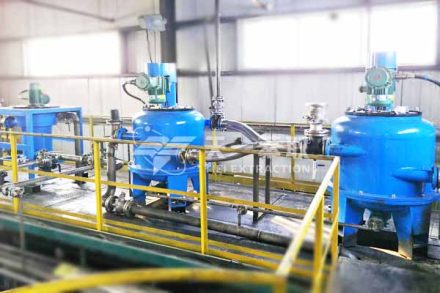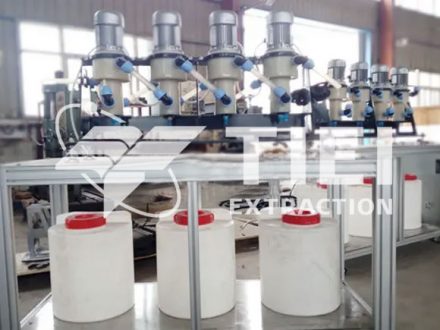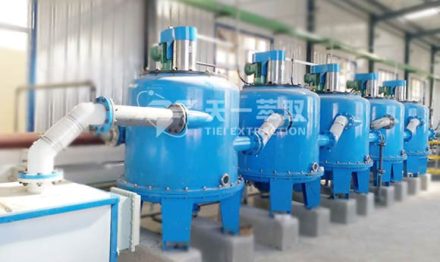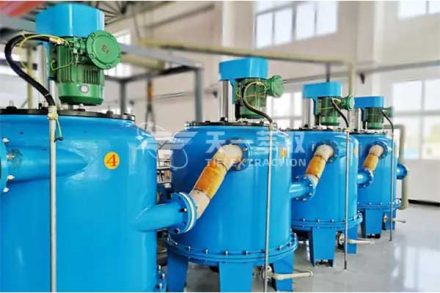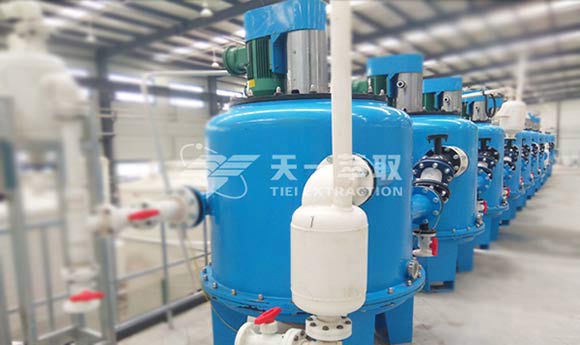
In the metal processing, electroplating, and steel industries, the pickling is an essential process. However, the large volumes of acidic wastewater generated—containing heavy metals such as zinc and iron—have become a major challenge for enterprises in terms of environmental protection and resource recovery. How to efficiently and economically separate and recover valuable metals from complex acid pickling waste liquids, turning “waste into wealth,” has become an urgent issue faced by many companies. Zhengzhou Tiei Extraction CWL-M series centrifugal extractor, with their superior performance, are becoming a new benchmark in the field of zinc-iron separation from pickling waste liquid.
Industry Pain Points: Limitations of Traditional Zinc–Iron Separation Processes
Traditional pickling wastewater treatment processes, such as neutralization precipitation and evaporation crystallization, generally suffer from the following problems:
- Low separation efficiency: It is difficult to achieve high-purity separation of zinc and iron, resulting in low product value.
- High operating costs: These processes require large amounts of reagents and energy, and generate large volumes of sludge that are difficult to handle.
- Large equipment footprint: The process flow is lengthy and requires multiple large tank-type units.
- Low level of automation: Heavy reliance on manual operation leads to poor stability and potential safety and environmental risks.
Centrifugal Extraction Process
The CWL-M Centrifugal Extractor adopts advanced centrifugal extraction technology, providing a new and highly efficient pathway for zinc–iron separation. Its core process flow is as follows:
- 1. Pretreatment
The acid pickling waste liquid is first filtered to remove suspended solids, preparing it for the extraction stage. - 2.Extraction Stage
The pretreated acid pickling waste liquid (aqueous phase) and a specific extractant (organic phase) are fed into the CWL-M centrifugal extractor at a controlled ratio.
Under the strong centrifugal field generated by the high-speed rotation, the two liquid phases are rapidly sheared, mixed, and allowed to react. The extractant exhibits high selectivity for zinc ions, efficiently “capturing” zinc from the aqueous phase into the organic phase, while most of the iron ions remain in the aqueous phase, thus achieving preliminary separation.
The mixed liquid then quickly separates under centrifugal force into a clear organic phase (loaded with zinc) and an aqueous phase (containing iron and other impurities), which are discharged through separate outlets. The entire process is completed within seconds, with extremely high efficiency. - 3.Washing Stage
To further improve zinc purity, the zinc-loaded organic phase can be fed into another CWL-M centrifugal extractor, where it is contacted with a small amount of washing solution (such as dilute acid) to remove trace impurities like iron ions. - 4.Stripping Stage
The purified zinc-loaded organic phase is sent to the third CWL-M centrifugal extractor, where it encounters a stripping agent (such as sulfuric acid).
Within the centrifugal extractor, process conditions (such as pH) are adjusted so that the extractant “releases” the zinc ions, transferring them into the stripping agent to form a zinc-rich solution (e.g., zinc sulfate solution).
The regenerated extractant is recycled back to the extraction stage, significantly reducing operating costs. - 5.Post-Treatment
Zinc-rich solution: Can be sold directly as a product or used to recover metallic zinc through processes such as electrolysis.
Iron-containing solution: Can be further processed to recover iron or produce iron-based products. The remaining wastewater can be treated easily to meet discharge standards.
By connecting several CWL-M centrifugal extractors in series, a continuous, closed-loop, and highly efficient automated production line is achieved.
Core Advantages of the CWL-M Centrifugal Extractor
- High Mass Transfer Efficiency and Excellent Stage Performance
The high-speed centrifugal force enables ultra-fine dispersion and intense mixing of the two phases, achieving a mass transfer efficiency far superior to that of traditional mixer-settler equipment. The extraction efficiency per stage can exceed 95%, significantly reducing the number of stages required and simplifying the overall process. - Short Residence Time and Minimal Liquid Hold-up
The materials remain inside the extractor for only a few seconds, and the system’s liquid hold-up is extremely low. This not only minimizes the amount of expensive extractant in circulation but also fundamentally reduces safety and environmental risks associated with material degradation or solvent evaporation. - Strong Adaptability and Large Processing Capacity
The CWL-M system can effectively handle emulsifying systems and is highly adaptable to the complex conditions of acid pickling waste liquids. It offers a complete range of models with processing capacities ranging from a few liters per hour to hundreds of cubic meters per hour, meeting the needs of enterprises of different sizes. - Fully Enclosed Operation for Safety and Environmental Protection
The equipment operates in a completely sealed state, effectively eliminating common issues in tank-type systems such as leakage, spillage, and evaporation. Unorganized VOC emissions are extremely low, providing strong support for enterprises to achieve green and safe production. - High Automation and Reduced Operation & Maintenance Costs
The centrifugal extractor starts and stops quickly, is easy to operate, and supports fully automatic continuous operation, greatly reducing the need for manual intervention. Its modular design offers a small footprint, convenient installation, and simple maintenance—making overall investment and operating costs highly competitive.
Welcome contact us for more details
Email: sales@tieiextraction.com
Whatsapp: +86 19069612820

